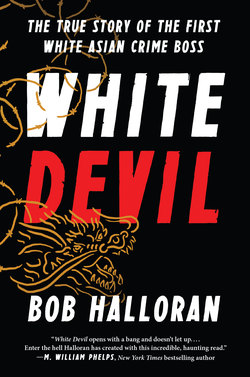Читать книгу White Devil - Bob Halloran - Страница 7
На сайте Литреса книга снята с продажи.
ОглавлениеINTRODUCTION
IMET JOHN WILLIS at FCI Cumberland, a medium-security federal prison in Cumberland, Maryland, in the winter of 2014. After being cleared through security, I was taken to a small room with a table and two chairs. I sat with my back to the window overlooking the prison yard and facing the visitors’ room where several families spent time with dozens of inmates. It was a casual atmosphere with children playing and guards providing plenty of freedom to mingle.
After a few minutes, John walked in unaccompanied by a guard. He wore an orange jumpsuit, and he wasn’t handcuffed. I don’t think I expected him to be restrained, but I found myself surprised to be left alone in a room with a criminal known to have a violent past. I stood up and John shook my hand with a friendly greeting. And then we talked for three hours.
He was at all times engaging, charming, and clearly intelligent. He was never intimidating. His voice stayed low and under control. He didn’t smile often, but there wasn’t a lot of humor in our conversation. He wanted to tell his story, and he knew I was the person who would tell it. I think he was honest about everything he said, though there were some things he was reluctant to discuss.
For instance, I thought it was interesting when I asked him if he had ever killed anyone, and he smiled a little, and said: “I can’t answer that.”
“Well, if you asked me that question,” I responded, “I could answer it. It would be easy. I’d say, ‘No.’”
I don’t know if John’s nonresponsiveness means that he has committed murder, or if he just wanted me to think that he might have. I think he’s fond of his reputation as a tough guy, and sees the benefits of people thinking he’s capable of murder.
In any event, I liked my time with John. We spent three hours the first day and four more the second. I grew very comfortable with him as we debated religion, God, philosophy, honor codes, self-determination, self-preservation, and the Boston Red Sox.
I drove away with seven hours of recorded conversation, all of which would be transcribed for accurate quotes, and all the information John gave me would need to be corroborated by other witnesses, investigators, wiretaps, federal or criminal court documents, and newspaper accounts. I also had several hours of transcribed interviews from my manager, Matt Valentinas, conducted separately with John and his girlfriend, Anh Nguyen. That information, along with my own interview with Anh, formed the basis of a lengthy research process that included additional interviews with members of John’s family, social circle, one former gang member, and the FBI.
A wealth of information and detail came directly from the first and second superceding indictments in which a grand jury charged John and several others with drug trafficking and money laundering—charges to which John and most of his associates pleaded guilty. Those indictments included transcribed phone conversations recorded by legal wiretaps. They also confirmed and added details to John’s version of money seizures, drug buys, and his own purchases of luxury items such as boats, cars, and houses—all of which were cited in the money laundering charges against him.
Affidavits submitted by FBI Special Agent Timothy C. McElroy for the continued use of electronic surveillance and by FBI Special Agent Thomas Conboy in support of the government’s motion to detain certain defendants clearly laid out the case against John and his coconspirators, and led to court-approved wiretaps of nine targeted telephones for nearly six months. Three of those phones were John’s. And you will read excerpts of what investigators recorded.
The FBI built a case against John and more than two dozen others that included narcotics distribution, money laundering, illegal gambling, extortion, alien smuggling, racketeering, human trafficking, and prostitution. Only one accomplice, Colby Deering, took his case to court. The trial transcripts with several coconspirators testifying under oath further corroborated or illuminated my research.
There were several reports in the Quincy Patriot Ledger, the San Francisco Weekly, the San Francisco Chronicle, the Boston Globe, and the New York Times from which I used information, eyewitness accounts, and quotes. Those are not footnoted in the book for the purpose of fluid reading, but I acknowledge them here.
What I learned from combining John’s stories with diligent research was that John had been honest, though a bit fuzzy on details and names. For instance, when John told me about a friend of his being killed right in front of him in a parking lot, this is what he said:
“His name was Wing. He had just gotten out of prison for robbing jewelry stores in Lowell. I knew him when he got out. It would be 1994–95.”
Well, as it turns out, a man named Chay Giang was killed in that parking lot under the same circumstances John described, but it happened in 1991.
John simply knew Chay Giang as Wing the same way he knew his own boss as Bai Ming, even though Bai Ming also went by Bike Ming, and his real name is Tan Ngo. Another criminal convicted under the name Truong Chi Trung was known by many as either Ah Sing or Ay-yat. John refers to him as Pida; although for quite a while I thought he was saying “Peter.” Clarifying all the aliases and discovering that many Asian gang members used Americanized names like Kevin or William was one of the more difficult challenges in assuring the information in this book is accurate.
Some names have been changed to protect the privacy of some individuals, but I offer a good-faith assurance that all other information is factual.
